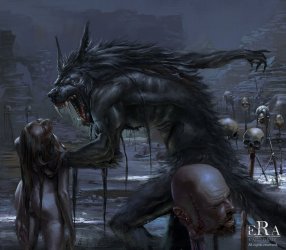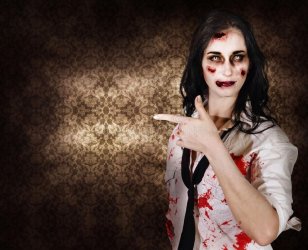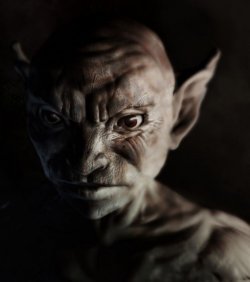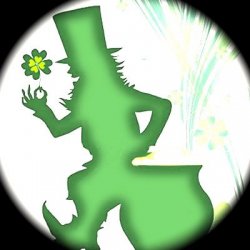- Sep 22, 2013
- 4,956
- 250
- 85
Around the world, we've celebrated outlandish/terrific folk-tales and ghost-stories about fantastic creatures and humanoids and spectres that capture our fascination with the 'other-worldly.' Indeed, recent horror-films in America have explored this social fascination with the 'enigmatic' aspects of spiritualism and existence, such as Ouija: The Origin of Evil, Gnome Alone, Jeepers Creepers, Leprechaun: Origins, and Army of Darkness.
These social 'art symbols' represent our fascination with the odd side of metaphysics and our interest in indulging superstition itself.
"Definition of superstition. 1 a : a belief or practice resulting from ignorance, fear of the unknown, trust in magic or chance, or a false conception of causation" (Merriam-Webster Dictionary).
Creating 'speculations' of causation in the face of uncertainty or constructing 'models' of non-causal phenomena (i.e., 'magic') comprises the 'brunt' of human superstition. We might feel superstitious if we break a mirror or see a black cat or find a lucky 4-leaf clover (etc.).
Superstition is a part of human consciousness and should not be taken lightly by serious investigators. When a medical patient seems to exhibit symptoms of hypochondria (irrational fears of non-existent maladies), doctors are requires to evaluate why the patient insists he/she is a 'victim' of circumstance and thereby arrive at helpful conclusions regarding the treatment of panic and general self-doubt.
So understanding/appreciating the 'realm' of superstition seems to obligate us to analyse why we celebrate folk-tales (around the world) about the 'strangeness' of perception and behaviour.

====
A werewolf is a human who transforms into a semi-wolf creature when it is wandering around in the light of a full-moon. The moon's gravity affects the tides of Earth's oceans, so there's a 'metaphysical' or 'imaginative' human allure towards the 'affect' of the moon itself, and women may even gauge their menstrual cycles around the calendar-cycles of the moon. This blood-brain draw towards the moon may explain why we'd want to make outlandish/superstitious tales of humans obsessed with moonlight and transforming into 'werewolves.'

A folk-tale of an 'evil woman' who is perhaps a zombie of some kind (an undead person who really should be dead!) or a vampire (a blood-sucking cannibalistic female) might invoke our superstitions about hygiene and etiquette. We want out blood-circulation to be clean, and imagining 'beings' who drink blood (vampires) reflects our superstition about the strangeness of vitality and lifespan. We do after all imagine creating genetically-cloned humans and A.I. robots who might possess the ability to live very long lives. This seems to be an overall 'aesthetics-superstition,' which is why female vampires are often portrayed as seductive or attractive/beautiful.

A forest-omen or spook-story of an eerie troll-like humanoid or vengeful gnome represents our superstitions regarding abandoning Mother Nature in favour of the modern city, which would 'synthesize' spectres of evolutionary 'fury.' These forest creatures (or gnomes) capture our strange curiosity about the morphology of evolution and the oddness of existence itself. Why would we be superstitious about confronting a food-stealing mischievous gnome while we're on vacation from our Wall Street jobs, camping in the woods of the Pine Barrens in New Jersey (USA)?

As with all eerie tales, there are 'benevolent' complements. In this matter, we know of 'delightful' Irish folk-tales of wondrous and friendly leprechauns (semi-gnomes) who hide pots of magical gold at the end of rainbows and sensational fairies (tiny winged humanoids) who fly around in the forest. Nature does, after all, provide us with numerous 'natural wonders' such as geometrically perfect semi-circle rainbows, geometrically perfect spherical planets, and perfect cyclone-shaped giant tornadoes. Therefore, we entreat our superstitions about encountering the 'magic of living.'

An artist may even create a rendering of a hillside/valley inhabited by numerous gorgeous tiny female humanoid semi-fairies who 'guard/protect' special places in nature. Sightings of strange creatures/beings such as the Cottingley Fairies in the time of Sherlock Holmes author Arthur Conan Doyle reveal our human curiosity about 'detecting the other-worldly.' There's nothing wrong with entreating such daydreams, but we should appreciate why these 'tales' entice our general superstitions about mortality. Why for example would we characterize beauty itself as mysterious? Are we afraid of dealing with the intolerable?

Author Lewis Carroll introduced us to the strange perceptual-enigma world of mirrors and reflections and gave us the fictional character Alice who discovers an entire universe of logical-profundity and strangeness on the flipside of a simple mirror and on the opposite end of a mysterious hole in the ground. Geometrician/logician/artist MC Escher also gave us representations of the strange interconnectedness of compatible geometric shapes such as triangles and circles which generate forms of nearly-perfect idealizations such as cones as well as surprisingly intricately intersecting lattices/matrices. Are we seduced by mirrors and reflection/congruence itself? What's so special about detecting 'similarity' (as a concept)?

A number of new age comic book characters such as Mandrake the Magician, Dark Phoenix, Mysterio, Lucifer Morningstar, and the Riddler capture our modern fascination with the 'realism' of magic and superstition and the notion of individuals/beings exhibiting extraordinary powers representative of our curiosity about magic and mortality. Should we treat these 'superstition-avatars' as indicative of our enduring intellectual(!) fascination with the completely inexplicable?
====

These social 'art symbols' represent our fascination with the odd side of metaphysics and our interest in indulging superstition itself.
"Definition of superstition. 1 a : a belief or practice resulting from ignorance, fear of the unknown, trust in magic or chance, or a false conception of causation" (Merriam-Webster Dictionary).
Creating 'speculations' of causation in the face of uncertainty or constructing 'models' of non-causal phenomena (i.e., 'magic') comprises the 'brunt' of human superstition. We might feel superstitious if we break a mirror or see a black cat or find a lucky 4-leaf clover (etc.).
Superstition is a part of human consciousness and should not be taken lightly by serious investigators. When a medical patient seems to exhibit symptoms of hypochondria (irrational fears of non-existent maladies), doctors are requires to evaluate why the patient insists he/she is a 'victim' of circumstance and thereby arrive at helpful conclusions regarding the treatment of panic and general self-doubt.
So understanding/appreciating the 'realm' of superstition seems to obligate us to analyse why we celebrate folk-tales (around the world) about the 'strangeness' of perception and behaviour.

====
A werewolf is a human who transforms into a semi-wolf creature when it is wandering around in the light of a full-moon. The moon's gravity affects the tides of Earth's oceans, so there's a 'metaphysical' or 'imaginative' human allure towards the 'affect' of the moon itself, and women may even gauge their menstrual cycles around the calendar-cycles of the moon. This blood-brain draw towards the moon may explain why we'd want to make outlandish/superstitious tales of humans obsessed with moonlight and transforming into 'werewolves.'

A folk-tale of an 'evil woman' who is perhaps a zombie of some kind (an undead person who really should be dead!) or a vampire (a blood-sucking cannibalistic female) might invoke our superstitions about hygiene and etiquette. We want out blood-circulation to be clean, and imagining 'beings' who drink blood (vampires) reflects our superstition about the strangeness of vitality and lifespan. We do after all imagine creating genetically-cloned humans and A.I. robots who might possess the ability to live very long lives. This seems to be an overall 'aesthetics-superstition,' which is why female vampires are often portrayed as seductive or attractive/beautiful.

A forest-omen or spook-story of an eerie troll-like humanoid or vengeful gnome represents our superstitions regarding abandoning Mother Nature in favour of the modern city, which would 'synthesize' spectres of evolutionary 'fury.' These forest creatures (or gnomes) capture our strange curiosity about the morphology of evolution and the oddness of existence itself. Why would we be superstitious about confronting a food-stealing mischievous gnome while we're on vacation from our Wall Street jobs, camping in the woods of the Pine Barrens in New Jersey (USA)?

As with all eerie tales, there are 'benevolent' complements. In this matter, we know of 'delightful' Irish folk-tales of wondrous and friendly leprechauns (semi-gnomes) who hide pots of magical gold at the end of rainbows and sensational fairies (tiny winged humanoids) who fly around in the forest. Nature does, after all, provide us with numerous 'natural wonders' such as geometrically perfect semi-circle rainbows, geometrically perfect spherical planets, and perfect cyclone-shaped giant tornadoes. Therefore, we entreat our superstitions about encountering the 'magic of living.'

An artist may even create a rendering of a hillside/valley inhabited by numerous gorgeous tiny female humanoid semi-fairies who 'guard/protect' special places in nature. Sightings of strange creatures/beings such as the Cottingley Fairies in the time of Sherlock Holmes author Arthur Conan Doyle reveal our human curiosity about 'detecting the other-worldly.' There's nothing wrong with entreating such daydreams, but we should appreciate why these 'tales' entice our general superstitions about mortality. Why for example would we characterize beauty itself as mysterious? Are we afraid of dealing with the intolerable?
Author Lewis Carroll introduced us to the strange perceptual-enigma world of mirrors and reflections and gave us the fictional character Alice who discovers an entire universe of logical-profundity and strangeness on the flipside of a simple mirror and on the opposite end of a mysterious hole in the ground. Geometrician/logician/artist MC Escher also gave us representations of the strange interconnectedness of compatible geometric shapes such as triangles and circles which generate forms of nearly-perfect idealizations such as cones as well as surprisingly intricately intersecting lattices/matrices. Are we seduced by mirrors and reflection/congruence itself? What's so special about detecting 'similarity' (as a concept)?

A number of new age comic book characters such as Mandrake the Magician, Dark Phoenix, Mysterio, Lucifer Morningstar, and the Riddler capture our modern fascination with the 'realism' of magic and superstition and the notion of individuals/beings exhibiting extraordinary powers representative of our curiosity about magic and mortality. Should we treat these 'superstition-avatars' as indicative of our enduring intellectual(!) fascination with the completely inexplicable?
====

